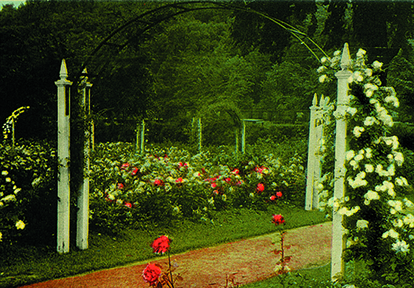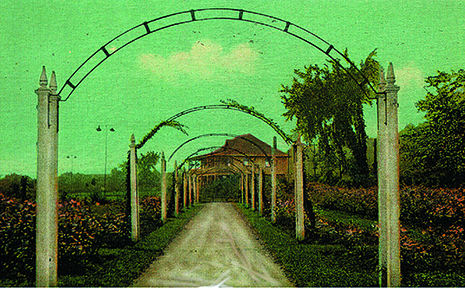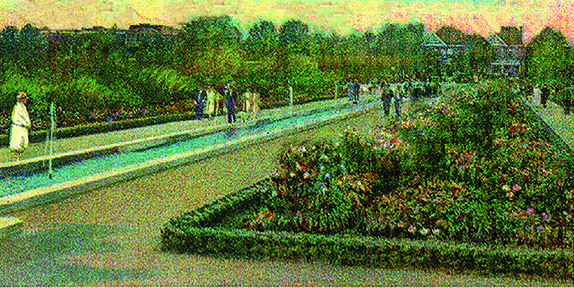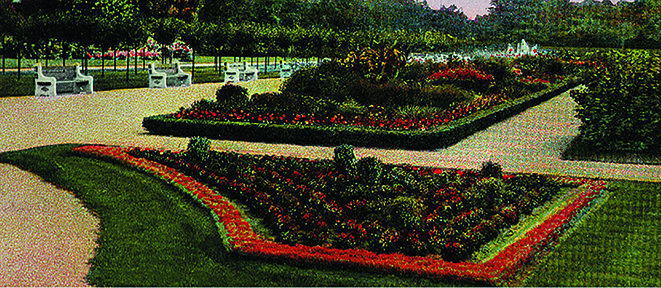How Gage Park came to be…
PARK PLANNING & DESIGN
Dunington – Grubb Landscape Architects
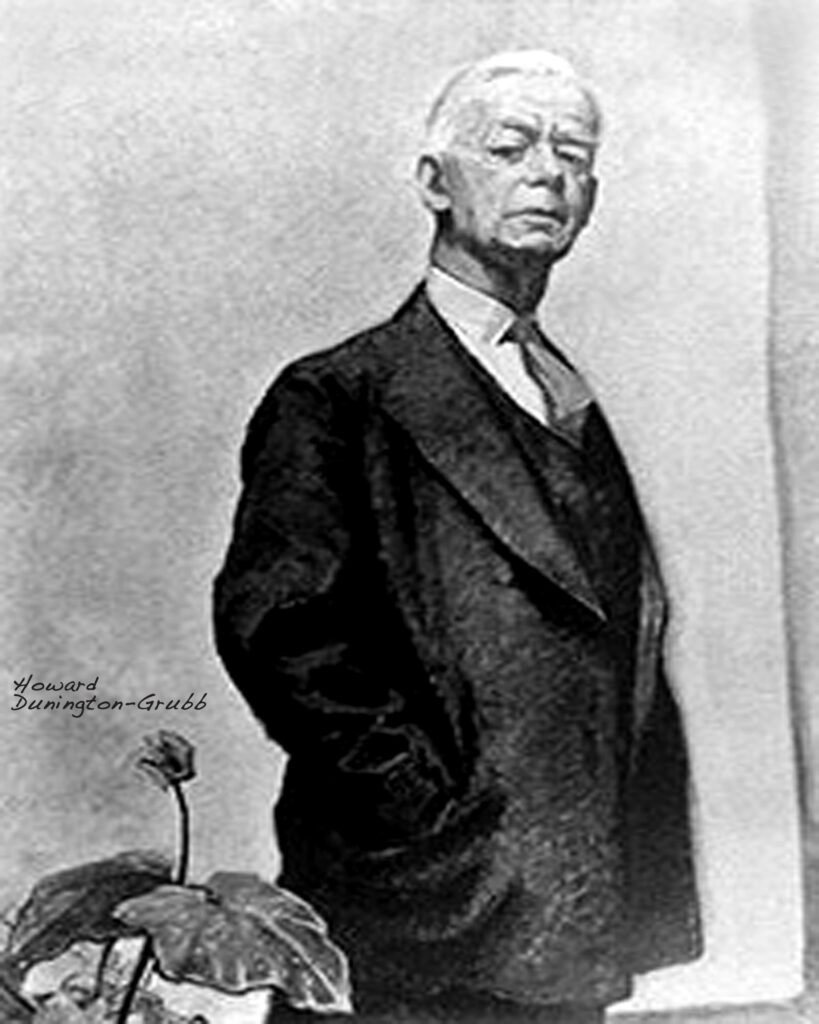
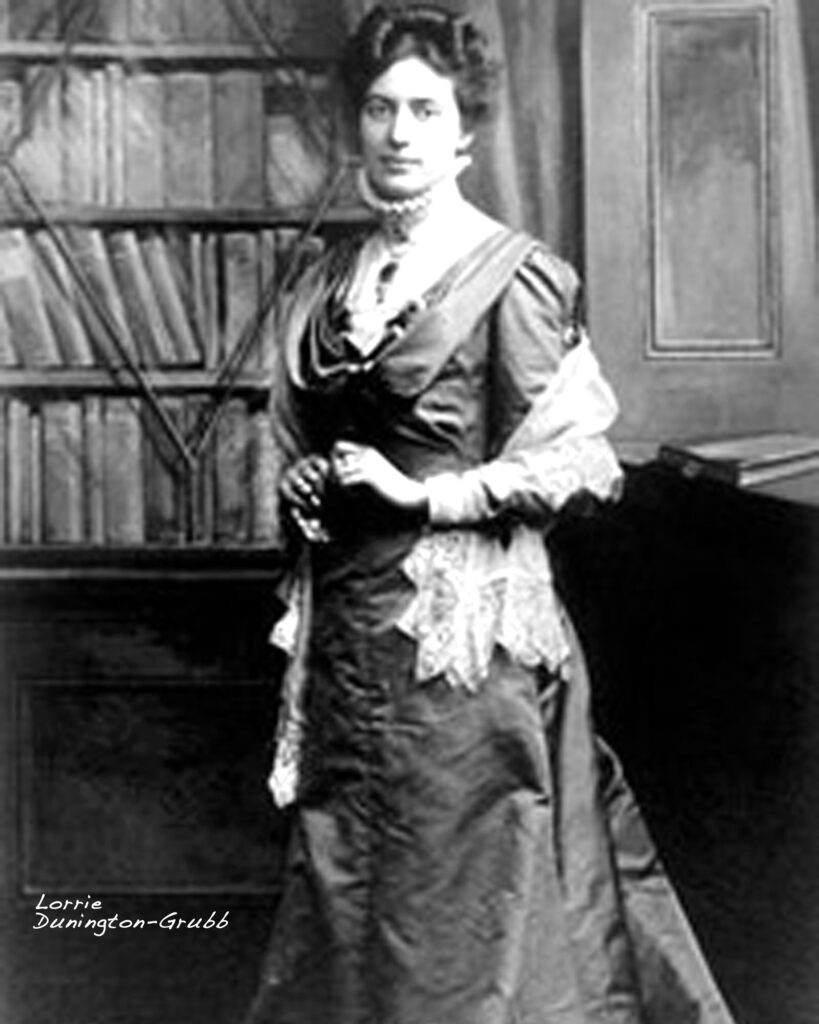
In 1911, Howard Grubb and Lorrie Dunington, both landscape architects, were married in England. That year, they immigrated to Canada and set up an office in Toronto.
They wrote on and taught garden design and produced a vast number of residential and commercial designs in Toronto, around the province, the country, and abroad.
A few examples are University Avenue in Toronto, Parkwood, the estate of R.S. McLaughlin in Oshawa, and the Rainbow Bridge Gardens in Niagara Falls.
In 1913, they founded Sheridan Nurseries to produce plants for their many projects.
Locally, Howard and Lorrie Grubb were strongly promoted by Parks Board member Thomas McQuesten.
Hamilton Commissions
From 1919 to 1927, Dunington-Grubb were the landscape architects for Gage Park.
In 1926-27, they prepared a Master Plan for the northwest entrance of the City including the High Level Bridge and the surrounding area.
In 1927, they designed the entrance to McMaster University and the renowned Sunken Gardens, which were destroyed for an expanded plan of the McMaster Medical Centre.
They also designed the gardens at Battlefield Park Stoney Creek and the perennial beds and sunken gardens at Whitehern, the home of Thomas McQuesten.
Howard Dunington and Lorrie Grubb’s designs reflect the City Beautiful movement of that time as can be seen in the formal gardens and expansive views of Gage Park.
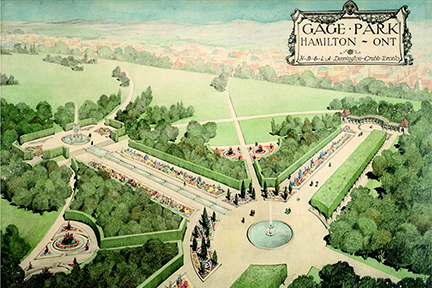
by S.H.Maw, 1927
Much of their original design can still be seen in the park.

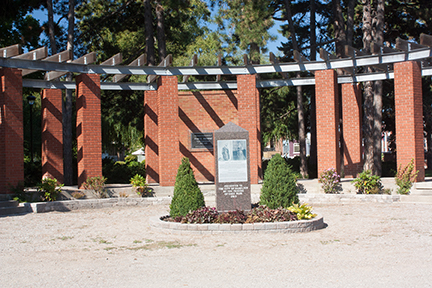
The Gage Park fountain was designed by John Lyle. Eugenie Gage sponsored its building. It was completed in 1927 and dedicated by Governor General Willingdon.
The fountain and its run off channel fit naturally into the design of the park.
The City of Hamilton restored the Dunington-Grubb Reflective Gardens as well as the main fountain to its original form in 2012/13 as part of a renewal plan for the park.
THE EAST END GAGE FAMILY OF HAMILTON ONTARIO
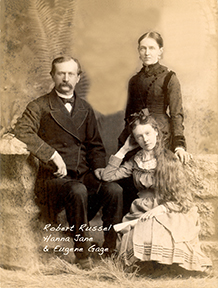
Eugena Gage
William Gage and James Gage were brothers originally from Londonderry Ireland. They came to North America at an early age, possibly with their parents around 1760-65. They settled on the Hudson River near Greenbush in New York State.
They married sisters William to Susannah Jones and James to Mary Jones.
During the revolutionary war they fought in the 2nd Ulster County Regiment of the New York Militia. James was killed defending Fort Clinton and Fort Montgomery on Oct. 6, 1777.
William and his family along with his brother’s wife Mary and her two children, James and Elizabeth, moved from Greenbush to Saltfleet Township in 1790.
Augustus Jones, Susannah and Mary’s brother had arrived in Upper Canada in 1857 as a land surveyor, followed by their brother Philip. The brothers settled in Stoney Creek.
William and Mary’s son James played a part in the battle of Stoney Creek, which is well documented.
The Gages gained a number of land grants. William accrued 1600 acres.
They also purchased property, which made them one of the most prosperous and respected families in Stoney Creek and Hamilton.
It was William and Susannah’s son Andrew (1777-1827) who carried the East End Gage family line forward. His first wife was Deborah Horning. One of their sons, James (1809-1881) married Eleanor Bates, mentioned below. After the death of Deborah, Andrew married Mary Huffman.
One of their sons was John Gage (1819-1900). He married Hanna Cline (1815-1882). One of their sons was Robert Russell Gage (1840-1918).
Andrew’s son James from above who married Eleanor Bates had a daughter, Hanna Jane Gage. She married Robert Russell Gage (1840-1918). He would eventually sell what is now Gage Park to the City of Hamilton in 1917. Robert and Hanna only had one daughter, Eugenie Gage, who never married. Therefore the line ended with her death in 1952.
The agreement to purchase the Gage land on Main Street East and Gage Avenue was completed by the City a year before the death of Robert Gage in 1917.
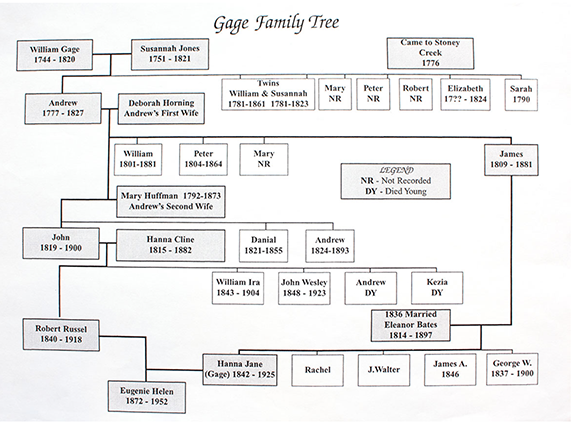
THE QUEENS PLATE
Elizabeth Gage, daughter of James Gage and Mary Davis Gage of the Stoney Creek Gages married Lewis Birely in 1826. Their daughter Kezia Adeline (1856-1917) married Robert Russell Waddell in 1850. Therefore Robert Russell Waddell and Robert Russell Gage were second cousins.
Robert Waddell was a Lawyer and lived on Rothsay Avenue where #40-42 stand today. It eventually became a boy’s home for “Home Boys”. This use continued for a number of years before it was torn down and the new housing build. This is the reason the two houses do not fit in with he other houses built at an earlier time when the street was developed.
Robert Gage’s home was not far away at what is now the Hamilton Children’s Museum.
Robert Waddell owned the west half at Gage Park and built what was called a Driving Park or horseracing track opening it in 1865.
The track was an oval and the west leg ran parallel to Gage Avenue from Main Street to the mountain. Lawrence road did not exist at that time. A portion of the walking path north of Cumberland is part of the original track.
The Queens Plate was run on the track in 1866 as part of the celebration for Queen Victoria’s birthday and the starter of that race was the well-known Hamiltonian William Hendry. The name of the winning horse was Beacon.
The second race was run in 1874. The winning horse was The Swallow and was owned by Hamiltonian Robert Thomson.
It was the only time that a Hamilton owned horse has won the Queens Plate.
Robert Waddell closed the park in 1874. It was re-opened in 1893 by the Hamilton Jockey Club. He died in 1894 and Robert Russell Gage purchased the land.
The Jockey Club then built a new track where the Centre Mall is located today (now, in 2022, The Centre on Barton).
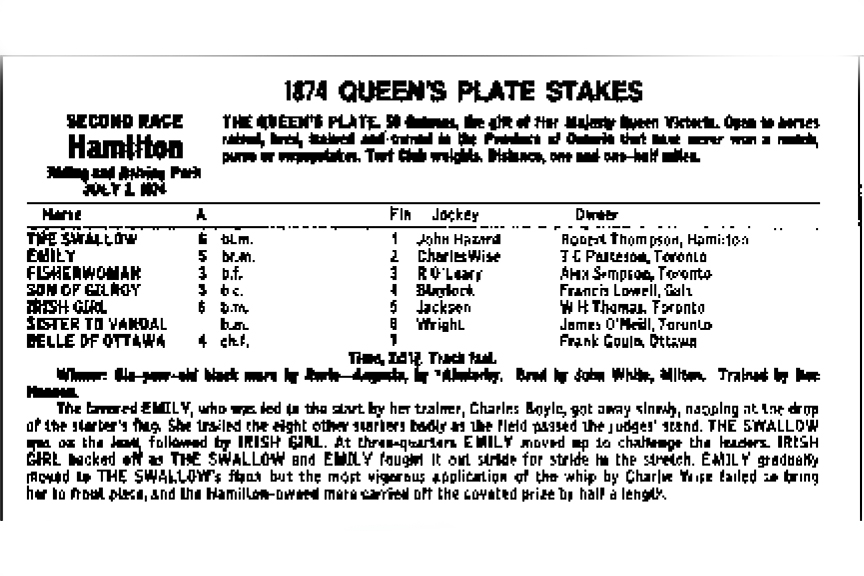
NOTE: Politicians lobbied to hold the race in their constituencies in the early years. It was raced in Ontario at Toronto, Guelph, St Catharines, Whitby, Kingston, Barrie, Woodstock, Picton, London, Hamilton and Ottawa before it settled permanently, with the Queen’s approval, in Toronto in 1883.
PRESS RELEASE
Hamilton’s Gage Park to Receive the Inaugural CSLA Legacy Project Award
Ottawa – May 30th, 2016 – Today, the Canadian Society of Landscape Architects (CSLA) announced that Hamilton’s Gage Park was selected as the recipient of the inaugural CSLA Legacy Project Award (2016).
According to Fred Eisenberger, Mayor of the City of Hamilton:
“To be the inaugural recipient of the CSLA Legacy Project Award is a great honour and nod to an iconic landmark in Hamilton,” said Mayor Fred Eisenberger. “Gage Park is a destination for cultural events that highlight the diversity in our community. The restoration of the fountain along with numerous upgrades preserves the legacy of the park and its’ original designers.”
Gage Park, built in a style reflective of the Canadian City Beautiful movement of the 1920s, is one of Hamilton Ontario’s most iconic, historical and cultural landscapes. Not only has it retained what were forward-thinking concepts when developed in the 1920s, but it has continued to evolve to serve the needs of the community. Components of the park design that were critical to the grand vision are the Great Lawn, the broad meandering walkway system, the relationships of formal and informal spaces, and the creation and preservation of dominant vistas to the Niagara Escarpment.
Gage Park contributes year round in the quality-of-life factor for the adjacent neighbourhoods. It makes the inner-city neighbourhoods more livable, it offers recreation opportunities for at-risk youth, low income children and low-income families, and it provides places where neighbours can feel a sense of community.
“Our community is proud to be home to one of Canada’s best urban parks. Gage Park has a long history of hosting cultural, musical, and community events while offering a quiet escape from urban life right in the heart of Hamilton. We are proud to receive the inaugural CSLA Legacy Award. As Hamiltonians, we continue to grow with Gage Park.” said Hamilton Ward 3 Councillor Matthew Green.
The CSLA Legacy Project Award is intended to recognize distinguished landscape architecture projects which were forward-thinking for their time, contribute significantly to their communities, showed leadership and innovation, and are still relevant examples of excellence in the profession of landscape architecture. This award honours projects which have left and continue to leave a lasting impact on Canada’s landscape. Gage Park is the first project to receive the CSLA’s Legacy Project Award.
The Legacy Project Award will be presented at a gala during the CSLA Congress to be held at the Fort Garry Hotel and Conference Centre in Winnipeg on Saturday, June 25th, 2016.
WHAT WAS; IS NO LONGER
TH&B engine 103, originally built in 1910 at the Montreal Locomotive Works (Builder’s number 48837), was originally No. 52 and later No. 72. Number 103 was selected from the TH&B roster for preservation in October 1956. The locomotive was given an overhaul and a new paint job, recreating her original appearance (except road number). She was put on display in Gage Park in the area of (now,2022) baseball diamond 3, parallel to Lawrence Road. Later, she was moved to Rockton at Jerseyville Station for use in the now (2022) Westfield Heritage Centre.
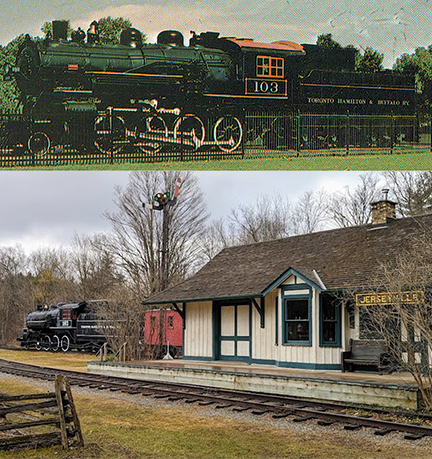
Below are some older Post cards and photos from the past.
The garden arrangements have changed a bit in the Park over time. This is a look back at “what was...”
Top Left & Center: Rose Garden by Sheridan Nurseries, Aug. 1928
